
Kumbi Kathawa
A story which highlights many themes and messages:
|
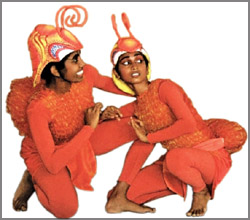
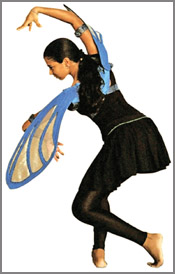
INVASION: The mosquito attacks the ants
|
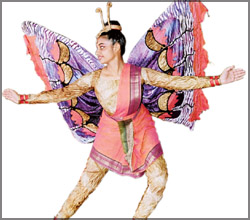
FESTIVITY: Songs and dance from
the butterflies |
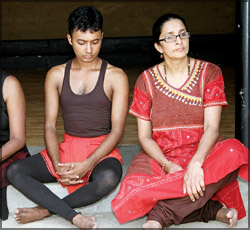
DUAL EFFORT: Mahesh and Anjalika, the creators behindKumbi
Kathawa |

TRADITION HANDED FROM GENERATION TO GENERATION: The Chitrasena family who
are linked with the creation |
BALLET: Await Kumbi Kathawa (Ant story), the newest children’s ballet
from the Chitrasena Kalayathanaya will go on boards at the Bishop’s
College Auditorium on September 7 and 8 at 6 p.m. and 8 p.m. and on
September 9 at 5.30 p.m. and 7.30 p.m.
The Chitrasena-Vajira combination is renowned for inventing a dance
form with the Sri Lankan touch - the Sinhala Ballet. Throughout the
years they have added many memorable productions to our aesthetic scene.
Adult ballets such as Karadiya, Kinkini Kolama and Nala Damayanthi
and children’s ballets like Hapana and Ran Kikili have won high
accolades from thousands of spectators, marking them down as a part of
our cultural heritage. Now Kumbi Kathawa, yet another children’s ballet,
is ready to succeed its ancestors.
Kumbi Kathawa is a story of which brings forth many human qualities
such as the strength of unity, work for the greater good of the
community, greed and corruption, not succumbing to despair, a positive
outlook towards life, quick thinking in a moment of crisis, forgiveness
and compassion. The participants of the ballet are children who have
been students for between one to 20 years at the Chithrasena - Vajira
dance foundation.
Anjalika (Chitrasena and Vajira’s daughter) and Mahesh are the
directors of Kumbi Kathawa and the story drew its inspiration from a
popular Russian children’s tale.
The duo also got together to design the stage sets and costumes. It
took them five years to put this creation together. Two foreign students
from San Diego will also take part. Kumbi Kathawa is supported by the
Nation’s Trust bank.
Kumbi Kathawa does not include ants alone. Audiences will be
captivated by the graceful movements of characters portraying
butterflies, grasshoppers, ladybirds, fireflies and a mosquito. Their
goal is to transport the beholders into a fantasy realm of the insect
world.
|
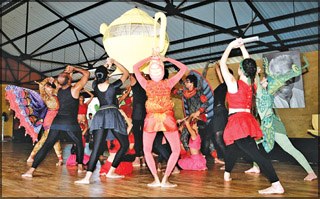
ENTERTAINMENT: A scene from the tea party |
The ballet will open with a scene of the ants’ daily life style. They
are known to be hard workers and that is exactly what the opening will
portray as figures dressed in colourful costumes scurry along the stage.
Then after a sequence of entertaining scenes comes the enemy! The
mosquito invades the stage and the dwelling of the ants. Tragedy and
danger follows and the ants have to flee in search of a new home.
Feelings of discouragement and pessimism exist but strong emotions and
bonds hold them together.
Pictures by Palitha Gunasena
‘AYA 2007’ highlights young artistic qualities
Thilak Palliyaguruge

A painting by
Jeewantha Samarakoon |

A painting by
Pulasthi Handunge |
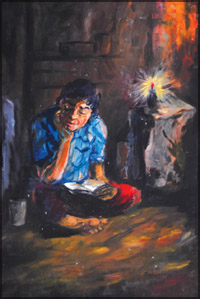
A painting by
Sakunthala Edirisooriya |
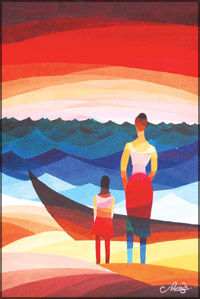
A painting by
Nisansala Wickramasinghe |
PAINTINGS: The Alliance française de Kandy, established in Kandy in
1967, has now reached the prestigious age of 40 years delivering
remarkable service to the field of promoting French language and
culture. To celebrate this historic event the institution has programmed
a series of cultural events throughout the year.
AYA 2007 is one of the major events in their cultural calendar which
will be held at the auditorium of the institute from September 7 to 14.
The concept of AYA was conceived by Dr. Jacques Soulié, the Director
of Alliance française de Kandy in 2003 and emerged as an annual cultural
event.
Fifty paintings selected from entries submitted by 18 Alliance Young
Artists who have successfully participated in the past AYA exhibitions
will be on display. The participants are from Kandy, Gampola, Matale,
Mawanella and also from distant southern town of Matara.
The paintings submitted for display are mostly done in water and oil
colours. There are few positive examples of major talents in the making.
Some of the paintings reveal the use of bold brush strokes with greater
freedom, harmonious blending of forms and colour and also fresh creative
vigour and maturity.
AYA 2007 is a rare aesthetic encounter which offers rich and
rewarding visual pleasure for the art lovers of the Hill Capital.
Fantasy finds solace with art
|

ARTIST OF SEMI ABSTRACTS: Vajira Gunawardena. Picture by Palitha
Gunasena
|
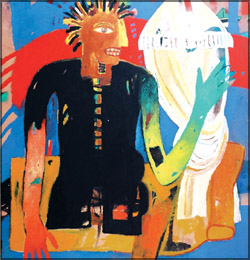 |
 |
|
DAILY LIFE VS
ABNORMALITIES: Two of Vajira’s creations. |
PAINTINGS: To paint a picture or design a form of artistic creation,
the artist needs to be able to see what he is doing. This may seem
oblivious but it is important for the visual arts are those most
directly linked to our physical senses - more particularly the sense of
sight. This does not mean that the artist is limited by what he can see.
Nothing could be further from the truth for each human being has his
own view of the world about him and what the artist ‘sees’ and tries to
express is personal to him. His work is influenced not only by his
experience, temperament, knowledge and understanding but by his
particular emotions at a given time.
This is Vajira Gunawardena’s approach to painting. The artist will be
holding an exhibition of oil paintings titled “The Dream Factory” at the
Barefoot Gallery from August 30 to September 9.
“My work is always connected with my daily life. My creations spring
out of the social and political structure of the modern era. I seek the
perfectly ordinary events in day-to-day life but this is driven from a
very limited point of recognition.
The reality is that this is like a blissful blindfold and the
abnormalities of the world are neglected. There is only one method for
us to bring it to the rear - through art. The artistic touch is the
gleam in the thick darkness or shadow in the light of day,” expressed
Gunwardena.
The artist’s work consists of semi abstract images: disfigured human
profiles, heroes with exceptionally enlarged sexual organs, politics and
war, Sri Lankan materialistic fantasy, new individualism, daily life
experiences, television, market force, consumer goods and figures of
popular commodities in the urban life as chosen signs with text and word
of commercial myth.
“Art is a medium from which I express my emotions of the contemporary
social environment. It is like a visual diary unfolding before my eyes.
It depicts the external struggle of a contemporary Sri Lankan
personality who was born embodying this culture,” he explained adding
that he prefers to use exceptionally bright colours in his work.
Why did you name the exhibition “Dream Factory”?
“We live a constructed lifestyle. Each one of us has a stereotyped
series of events, which go along with our status mechanically. These
paintings portray the issues faced by people which are different from
their fantasy of a ‘perfect life’.”
“Two ideas emerge with painting: how to paint and what to paint. We
need to explore more on what to paint because we can learn the styles of
paintings at an institute. An artist is born out of the way he thinks,
not from the medium he uses,” he said.
“The Dream Factory” will be Gunawardena’s third solo exhibition.
He is the holder of a Bachelor of Fine Arts Degree from the Institute
of Aesthetic Studies in the University of Kelaniya and has a diploma of
production design at the Sri Lanka Designing Department with the Cottage
and Textile Industries Department.
He held his first solo exhibition, “My Recent Paintings”, in 2005 at
the Paradise Road Gallery, Colombo, and his second in 2001 at the Lionel
Wendt Art Gallery. Gunawardena had also taken part in many group
exhibitions and had even presented his work at the “12th Asian Art
Biennale Bangladesh 2006” held in Dhaka in 2006.
He will be representing South Asia in a residential artists’ camp in
Spain in October.
Sinhala cinema boosts social integration
Arul Sathya
|
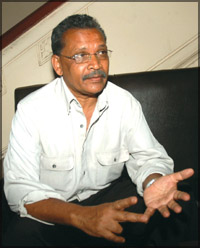
Vibrant Tamil writer plus rationalist: M. Sivalingam
|
CINEMA: South Indian Tamil movies like Sivaji are runway hits not
only in Sri Lanka but the world over, but Bollywood seldom produces good
movies. The Sinhala cinema industry has produced many remarkable movies
and managed to earn a good name. Movies such as Ammawarunae and
Uppalavanna are much far better movies than most of the Indian hits.
This was the revelation of M. Sivalingam, vibrant Tamil writer and a
rationalist, who came out of Regal theatre after watching Uppalavanna
and met me at the Lake House reception.
Sivalingam, who received the Sahitya award twice, one in 1993 and the
second in 2004, is leading a moderate life in Kotagala. Though he isn’t
a frequent moviegoer, he doesn’t miss a good Sinhala movie.
“The Sinhala cinema industry is very small. It has no worldwide
marketing network as South Indian movies. But from Gamperaliya onwards,
our movie scene has produced several milestone movies such as Ahasgawwa,
Nidhanaya, Palangetiyo and now Uppalavanna. All these movies are of
social value, an inseparatable component of Buddhist culture.”
Sivalingam has so far released three books, two short story
collections and one translation. ‘Born to labour’ is the book he
translated into Tamil, a book by the English writer from the plantation
community, the late C.V. Velupillai, Sivalingam who had written more
than 50 short stories and 20 of his plays had been staged in Colombo and
in plantation areas. He owns many comedy and satiric articles. All of
his books and writings have one thing in common, his concern for social
uplift.
He remains as the founder member of the Upcountry People’s Front and
at one time its general secretary. He was also the former deputy
chairman of the central provincial council. Perhaps he is the one and
only upcountry Tamil politician who were able to engage in creativity.
“A politician who also has the ability in creative writing will
understand people’s problems much better” he pointed out. But will such
politician be successful in today’s political atmosphere?
Perhaps not. Coming back to the Sinhala cinema, Sivalingam
categorised Ammawarunae and Uppalavanna as films of Buddhist views on
human life entangled between war and social life while Purahanda
Kaluwara as a movie trying to reiterate the evil behind war.
He also observed that there are many young Sinhala directors who are
willing to speak against war and social inequality through their movies.
This is highly appreciated by the Tamil population.
“Art must unite and integrate communities and the Sinhala movie
industry and teledrama industry are playing significant roles in this
spectrum” he says.
He said that C.V. Velupillai is his guru. Veluppillai was born in
1914 at Madakumbura, Punduloya in a Kangani family, wealth enough to
educate him in English medium schools.
As far as I know, there is no match for C.V. Vellupillai in the Sri
Lanka literary field as he was an English poet, story teller and a
vibrant writer. When Rabindranath Tagore visited Colombo in 1943, C.V.
met him and gifted him with a book of poetic drama written by him and
dedicated to Tagore.
The book titled Vismadgene was published by ANCL. C.V. Velupillai
describes Vismadgene as a ‘book of lyrical drama in act. C.V. Velupillai
describes his book as the wild flower of his garden.
He studied at Holy Family (Nuwara Eliya), Islands (Hatton) and
Nalanda (Colombo) in English medium. All his literary works were in
English.
“Upcountry Tamils have a 200-year-old history but this community
failed to show its social value and the problem of the outside world
through its political strength but its plight was successfully revealed
by powerful writers and tireless workers such as C.V., Theliwatte
Joseph, Anthony Jeeva etc.
There are Tamil literatures in Tamilnadu literature, Malasian
literature, migrant literature (literature by those Tamils who migrated
from Sri Lanka and settled in various parts of the world) and upcountry
literature.
This upcountry literature is unique because it reveals the conquers
of the society. Upcountry is a beautiful place and there are so many
pretty things to influence the writers mind.
But these writers left them aside and created poems, short stories,
and novels using human sufferings, poverty and inequality as their base
for writing. The much awaited political strength came much later,”
Sivalingam further elaborated.
He said that he feels very sorry to note that very little effort have
been taken by the present generation to push the upcountry literature
forward. The upcountry youths have embedded themselves into the South
Indian cinema and highly commercial TV serials, which he observes
‘brought the creativity to a grinding halt’.
“We must learn from Sinhala artists. At the inception they inherited
from South Indian filmdom. Later they managed to free themselves from
Indian maya and created a powerful base rooted in Sinhala culture.
Upcountry Tamils failed miserably in doing this and is still under
the influence of Tamil Nadu’s commercial culture. We failed at what C.V.
built. But young Sinhala directors such as Prasanna Vithanage are doing
a wonderful job. They are also using this medium for community
integration,” says Sivalingam who is in his late 50s.
Murugan Sivalingam’s native place is Talawakelle, born at Middleton
estate. In 1965 he was at Virakesari the national Tamil newspaper,
working as a journalist and later became a teacher before he chose to
serve people through party politics.
“The need of today is a strong and visionary leadership with long
term objectives, but what we have is politicians aiming for the very
next election,” Sivalingam lamented.
Picture by Renuka de Alwis
Colours of healing
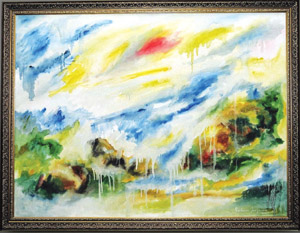 EXHIBITION: An exhibition of paintings by Madawa Sanjeewa was held
recently at the Lionel Wendt Art Gallery. An old boy of Ananda College,
Colombo, Sanjeewa received his primary training in engineering but he
also placed his first step into the field of art through his school
days. Then it had been a slow upward climb for this talented youth. He
had to engage in a mission of finding his own mode and style through
self study. EXHIBITION: An exhibition of paintings by Madawa Sanjeewa was held
recently at the Lionel Wendt Art Gallery. An old boy of Ananda College,
Colombo, Sanjeewa received his primary training in engineering but he
also placed his first step into the field of art through his school
days. Then it had been a slow upward climb for this talented youth. He
had to engage in a mission of finding his own mode and style through
self study.
Sanjeewa spent most of his leisure period embarking on a mission of
experimenting with the brush and pallet. He learnt to express the non
verbal languages of the inner self through the noble creativity of art.
He said that his work helps to relax the mind and leads to deep
thinking, bringing forth strong emotions and psychological therapy
through colours. He had won a number of medals, diplomas and
certificates for his creations.
 Media Personality Edwin Ariyadasa once expressed that the paintings
of Sanjeewa’s “as abstract in concept, communicating a sense of
tranquility. In a few he portrays human figures, expressing such
sensitive experiences as a mother’s love of her infant child... What
comes through all this is a deeply reflective attitude of mind. Media Personality Edwin Ariyadasa once expressed that the paintings
of Sanjeewa’s “as abstract in concept, communicating a sense of
tranquility. In a few he portrays human figures, expressing such
sensitive experiences as a mother’s love of her infant child... What
comes through all this is a deeply reflective attitude of mind.
His approach to art is meditative. It is as if he had concentrated on
the world outside as an object o meditation. His first solo exhibition
gives the viewer the impression that the artist possesses great
promise.”
Pictures by Palitha Gunasena
|

